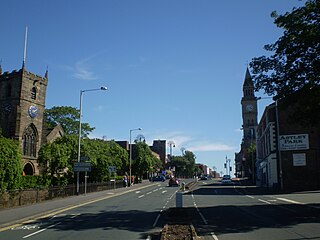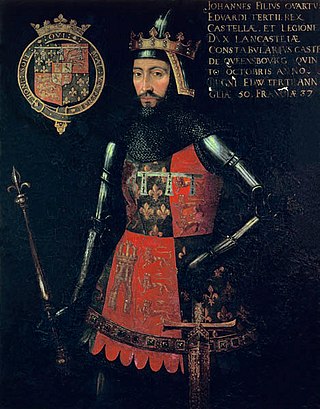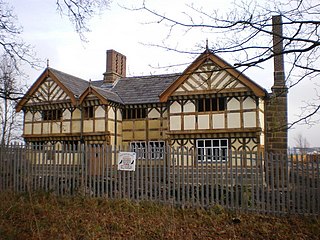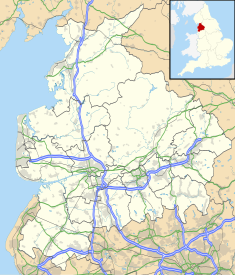
Chorley is a town and the administrative centre of the wider Borough of Chorley in Lancashire, England, 8.1 miles (13 km) north of Wigan, 10.8 miles (17 km) south west of Blackburn, 11 miles (18 km) north west of Bolton, 12 miles (19 km) south of Preston and 19.5 miles (31 km) north west of Manchester. The town's wealth came principally from the cotton industry.

The Borough of Chorley is a local government district with borough status in Lancashire, England. The population of the Borough at the 2011 census was 107,155. It is named after its largest settlement, the town of Chorley.

Towneley Park is owned and managed by Burnley Borough Council and is the largest and most popular park in Burnley, Lancashire, England. The main entrance to the park is within a mile of the town centre and the park extends to the south east, covering an area of some 180 hectares. At the southern end of the park is Towneley Hall, a grade I listed building housing Burnley's art gallery and museum. To the north are golf courses and playing fields and to the south 24 acres of broadleaf woodland. On the southern boundary is a working farm called Towneley Farm with pastures and plantations extending eastwards into Cliviger.

Chorley is a constituency in Lancashire represented in the House of Commons of the UK Parliament since 1997 by Lindsay Hoyle. Hoyle was originally elected for the Labour Party, but in 2019 became the Speaker, making him unaffiliated.

Clayton-le-Woods is a large village and civil parish of the Borough of Chorley, in Lancashire, England. According to the census of 2001, it has a population of 14,528. At the 2011 census the population of Cuerden civil parish was included within Clayton-le-Woods, giving a total of 14,532.

Anderton is a civil parish in the Borough of Chorley in Lancashire, England. It is now a suburb of Adlington, 5 miles (8 km) northwest of Bolton. Within its boundaries are the Rivington Reservoirs. Grimeford village is in the parish. In 2001, the parish had a population of 1,206, increasing to 1,316 at the 2011 census.

Charnock Richard is a small village and civil parish in the borough of Chorley, Lancashire, in England. The population of the civil parish taken at the 2011 census was 1,748.

Cuerden is a village and civil parish of the Borough of Chorley, in Lancashire, England. It is situated between Bamber Bridge and Leyland, and had a population of 77 in 2001. At the 2011 census the population was included within Clayton-le-Woods civil parish.

Heath Charnock is a small village and civil parish of the Borough of Chorley in Lancashire, England. According to the United Kingdom Census 2001 it has a population of 2,065, reducing to 2,026 at the 2011 Census.

The High Sheriff of Lancashire is an ancient officer, now largely ceremonial, granted to Lancashire, a county in North West England. High Shrievalties are the oldest secular titles under the Crown, in England and Wales. The High Sheriff of Lancashire is the representative of the monarch in the county, and is the "Keeper of The King's Peace" in the county, executing judgements of the High Court through an Under Sheriff.

St Saviour's Church is in the village of Cuerden, Lancashire, England. It is an active Anglican parish church in the deanery of Leyland, the archdeaconry of Blackburn and the diocese of Blackburn. The church is recorded in the National Heritage List for England as a designated Grade II listed building.

Cuerden Hall is a country mansion in the village of Cuerden near Preston, Lancashire, England. It is a Grade II* listed building. The Hall was formerly a family home between 1717 and 1906, and used by the Army until the 1960s. In 1985 it became a Sue Ryder neurological care centre. The Hall was sold to Manchester business man Colin Shenton in 2020 who is restoring it to its original purpose as a family home. The parkland and wider estate are known as Cuerden Valley Park. Cuerden Valley Park is now owned and managed by Cuerden Valley Park Trust which was a charity established in 1986, to ensure the longevity and management of the parkland itself. The Trust is made up for 650 acres of land; 1 reservoir, 15 ponds, 3 reed beds; over 5km of the river Lostock and 5 nature reserves.
Sir Peter Brooke was an English politician who sat in the House of Commons at various times between 1646 and 1656.

Duxbury Hall was a 19th-century country house in Duxbury Park estate in Duxbury Woods, Duxbury, Lancashire that has been demolished.
Thomas Charnock (1587–1648) was an English politician who sat in the House of Commons in 1624.

Thurnham Hall is a Grade I listed 17th-century country house in the village of Thurnham, Lancashire, England some 10 km south of Lancaster.

Buckshaw Hall is a grade II* listed 17th-century country house in Buckshaw Village, Euxton, some 3 miles (4.8 km) north-west of Chorley, England.

Robert Townley Parker (1793–1879) was a Unionist Member of Parliament for the United Kingdom House of Commons constituency of Preston.
Sir Henry Philip Hoghton, 7th Baronet (1768–1835) was a British politician who sat in the House of Commons from 1795 to 1802.

































